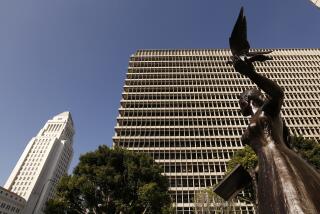Judge Tells Prosecutors to Justify Bid to Destroy Old Files
- Share via
Responding to a lawsuit filed by several defense lawyer groups, a Los Angeles Superior Court judge Wednesday issued an order compelling the district attorney’s office to explain next month in court why it should be allowed to destroy thousands of old files.
A lawyer representing the district attorney’s office said there are no plans for the immediate destruction of any records, adding that certain files would never be destroyed--among them murder cases and those involving jailhouse informants.
Los Angeles Superior Court Judge Diane Wayne set a Dec. 10 hearing. The hearing Wednesday was prompted by a lawsuit filed the day before by California Attorneys for Criminal Justice, a statewide defense lawyer group of about 2,100 members, and the 350-member Los Angeles Criminal Courts Bar Assn.
Defense attorneys, concerned that even one file might someday divulge a nugget that could clear someone wrongly convicted of a crime, contended that the destruction of any records would lead to incalculable harm.
It would be the “functional equivalent of burning a library,” Santa Monica defense attorney Gigi Gordon said.
Continuing the analogy, she said: “This is the criminal history of Los Angeles. And [prosecutors] don’t get to pick and choose which books get burned.”
Deputy Dist. Attys. Frank Sundstedt, Michael Tranbarger and Carol Najera--the prosecutors who have been most involved in the office’s campaign to be rid of older files--did not return calls Wednesday seeking comment.
The files at issue are those the district attorney’s office compiles and maintains in prosecuting felonies. Superior Court records are not at issue.
It is unclear how many files are at risk of destruction. The district attorney’s office files about 70,000 felony cases each year.
According to a letter Tranbarger wrote Nov. 14, 1995, to Sally Reed, then the county’s chief administrative officer, prosecutors believe they are entitled under law to destroy felony files more than 15 years old.
*
In the wake of a jailhouse scandal in 1988--an informant demonstrated that he could easily fake another inmate’s confession and fool police and prosecutors--the district attorney’s office agreed with defense lawyer organizations that it would preserve files involving known informants.
That agreement, which has been approved by a series of Superior Court judges, expires Monday.
Meanwhile, Sundstedt appeared in court last year to say that the district attorney’s office was nearing maximum storage capacity.
Tranbarger said in his letter to Reed that the office needed to destroy older records because of the cost and space it would take to store them--20,000 square feet and as much as $4.8 million over 10 years.
By contrast, he wrote, shredding costs would total $700.
Defense attorneys then surveyed Los Angeles-area storage facilities that were bonded and already kept various city or county records. Some estimates put the storage cost at less than $30,000 annually, according to Robert Berke, a past president of California Attorneys for Criminal Justice.
This summer, in hearings before Superior Court Judge John H. Reid, Najera announced a change in position. Regardless of cost or space, she said, prosecutors wanted to destroy older files.
“It’s not in the best interest of our client, the people of the state of California, to continue [an agreement] that forces us to keep our records in perpetuity,” Najera said July 1 in a hearing before Reid, according to a transcript.
On Sept. 3, in another court hearing, Najera told Reid that various files would be kept: those involving serious or violent felonies, murder cases and jailhouse informants.
On Wednesday, Deputy County Counsel Lane R. Brown said the list of files the district attorney’s office intends to maintain also includes those for which a “special request” is made that they be kept.
More to Read
Sign up for Essential California
The most important California stories and recommendations in your inbox every morning.
You may occasionally receive promotional content from the Los Angeles Times.













